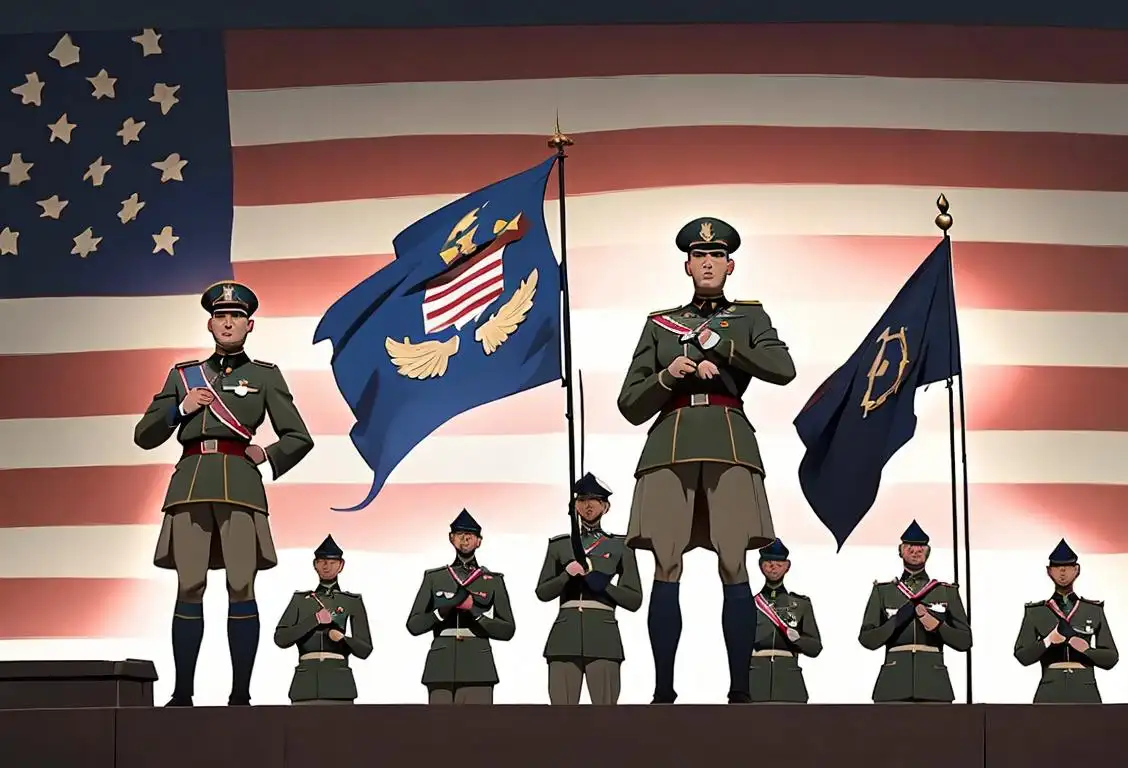National College Declaration Day

Hey there, college-bound adventurers! Do you hear that? It's the sound of pencils being sharpened, minds being expanded, and student loans magically disappearing... Okay, maybe not that last one, but it's National College Declaration Day, and we're here to celebrate all things higher education!
When is College Declaration Day?
It's national college declaration day on the 1st May.
The Origins of National College Declaration Day
Before we dive into the world of internet celebrations, let's take a quick trip back in time. National College Declaration Day dates back to the early days of the internet, when students eagerly awaited their college acceptance letters via snail mail (remember those?). It was a day of excitement, nerves, and a little bit of nail-biting.
As technology evolved and emails replaced envelopes, the internet caught wind of this momentous occasion and decided to give it the recognition it deserved: a national day! On May 1, 2019, the online world exploded with mentions of National College Declaration Day. Students took to social media to proudly declare their college choices, and friends and family showered them with virtual confetti.
How to Celebrate
Now, let's get down to the fun part: how to celebrate National College Declaration Day! Gather your loved ones, whip up some delicious snacks (we're partial to a good mac and cheese), and prepare for a celebration filled with joy, anticipation, and a sprinkle of nostalgia. Here are a few ideas to get you started:
- Have a virtual college reveal party: Just like a gender reveal party, but instead of pink or blue, it's all about which college you'll be attending!
- Create a college-themed playlist: Remember that song you listened to on repeat during your college application process? Add it to your playlist and let the nostalgia flow.
- Share your college decision on social media: Show off that acceptance letter or college t-shirt to your online community.
- Write a letter to your future self: Jot down your hopes, dreams, and expectations for your college experience. Open it four years later and see how far you've come!
Did You Know?
On National College Declaration Day, did you know that the most popular food among college students is pizza? It's the ultimate study fuel and late-night snack. Plus, it's practically a food group in its own right!
History behind the term 'College Declaration'
1636
Founding of Harvard College
Harvard College, the oldest institution of higher education in the United States, was founded in 1636 in Cambridge, Massachusetts. It was initially established to train young men for the ministry and to provide a place for Puritan leaders to receive an education.
1636
Founding of Harvard College
Harvard College, founded in 1636 in Cambridge, Massachusetts, is the oldest institution of higher education in the United States. The term 'college declaration' can trace its origins back to this prestigious institution.
1636
Puritan Education
In 1636, the term 'college declaration' originated in the context of Puritan education in New England. During this time, the Puritans believed in the importance of education and established the first college, Harvard College, in Cambridge, Massachusetts. The 'college declaration' referred to the formal declaration of entering college and the commitment to pursue knowledge and higher learning.
1826
The Birth of American College Football
In 1826, a year before the founding of the modern college, Yale University hosted the first recorded college football game between two student teams. This game, played with a round-shaped ball, laid the foundation for the development of college sports in America.
1636
The Birth of American Higher Education
In the year 1636, Harvard College was founded in Cambridge, Massachusetts, making it the first institution of higher education in the United States. The term 'college declaration' traces its roots back to this time when students at Harvard would formally declare their intent to pursue a certain course of study. This declaration was seen as a significant milestone in a student's academic journey and marked the beginning of their specialized education.
1663
The Birth of the Term
The term 'college declaration' was first used in 1663 to refer to a formal written announcement made by a college or university. These declarations were typically issued to communicate important information, such as the establishment of new academic programs, changes to existing policies, or updates on campus events.
1776
Declaration of Independence
In 1776, the Founding Fathers of the United States signed the Declaration of Independence, proclaiming the country's independence from British rule. This historic event further popularized the use of the term 'declaration' in American culture.
1821
The Establishment of the Modern University System
As higher education institutions evolved and began offering a wider spectrum of disciplines, the concept of a 'college declaration' gained prominence. In the year 1821, the University of Virginia was established, introducing a new model for higher education in the United States. This model emphasized interdisciplinary studies and the freedom for students to tailor their education to their interests. The 'college declaration' became a crucial process for students to state their choice of major or concentration within a specific college or school within the university.
1837
Rise of American Colleges
During the 19th century, the term 'college declaration' gained prominence in the United States as educational institutions multiplied and developed. American colleges and universities began using declarations as a means of disseminating information to their growing student bodies and faculty. These declarations were often posted on bulletin boards or circulated through pamphlets.
1700s
Expansion of Colleges
During the 1700s, the concept of 'college declaration' expanded as more colleges were established in different parts of the United States. This expansion was a result of the growing importance placed on education and the desire to provide opportunities for young individuals to pursue higher learning. 'College declaration' became a common term used to signify the formal process of admission and enrollment into a college.
1935
The Formation of the College Football Association
In 1935, the College Football Association (CFA) was established as an organization to regulate college football competitions and promote fair play. The CFA played a significant role in shaping the rules and structure of college football, including the declaration of champions and the organization of bowl games.
1776
The American Revolution
During the American Revolution, the idea of individual freedom and independence began to take root in the American colonies. Many colleges and universities, including Harvard, became centers of political activity and intellectual discourse. Students and faculty members often gathered to discuss and debate the revolutionary ideas that would shape the future of the country.
19th Century
Evolution of Admission Requirements
In the 19th century, colleges started evolving their admission requirements. The 'college declaration' became more than just a formal declaration of entering college; it started encompassing the documentation and paperwork required for enrollment. Students had to provide various documents such as academic transcripts, letters of recommendation, and personal statements as part of the 'college declaration' process.
1900
Formalization of College Governance
In the early 20th century, the governance of colleges became more formalized, leading to the increased use of college declarations. The growth of administrative structures and the need for standardized communications further popularized the term. Colleges recognized the value of clear and official announcements to ensure that important information reached all members of the institution's community.
1940
College Declaration as a Slang Term
Around the 1940s, 'college declaration' began to be used as a slang term among students to describe a bold and confident statement or assertion made by someone in a college setting. This usage highlighted the importance and influence of declarations within the academic community.
1951
Introducing the College Football Declaration
In 1951, the term 'College Football Declaration' was coined to refer to the formal announcement of a college football team's intent to participate in a specific bowl game. This declaration served as a way to generate excitement and promote the event among fans, media, and potential sponsors.
1930s
The Rise of Student Advising and Registration Systems
During the 1930s, universities started implementing comprehensive advising and registration systems to better guide students through their academic journey. These systems streamlined the 'college declaration' process, allowing students to receive guidance from academic advisors and officially declare their chosen field of study. The 'college declaration' became a pivotal moment for students as they received personalized advice and support to make informed decisions about their academic and career pathways.
1823
The Monroe Doctrine
In 1823, President James Monroe issued the Monroe Doctrine, which articulated the United States' policy of non-interference in European affairs and warned against any further colonization in the Americas. This declaration had a profound impact on the role of American colleges and universities, as it contributed to the development of a distinct American identity and fostered a renewed interest in studying and teaching American history and civics.
1862
The Morrill Act
The Morrill Act of 1862, also known as the Land-Grant College Act, granted federal lands to states to establish colleges that would focus on agricultural and mechanical arts education. This act marked a significant shift in the purpose and accessibility of higher education in the United States, as it aimed to provide practical and vocational education to a broader population.
1960s
Expanding Opportunities and Interdisciplinary Studies
In the 1960s, the higher education landscape witnessed significant changes. Many universities started offering more varied majors and interdisciplinary programs to meet the evolving demands of society. This expansion led to a more flexible 'college declaration' process, allowing students to pursue unique and innovative academic pathways across multiple fields. The term 'college declaration' continued to be used to refer to the act of formally choosing a major or concentration within a specific academic department or interdisciplinary program.
1992
The Birth of the Bowl Championship Series
In 1992, the Bowl Championship Series (BCS) was introduced as a system to determine the top-ranked team in college football. The BCS combined various bowl games and declared the winner of the BCS National Championship Game as the overall champion. The term 'College Football Declaration' gained further prominence as teams declared their participation in the BCS bowl games.
1960s
Counterculture and Activism
The 1960s saw a significant cultural shift, with college campuses becoming hotbeds of counterculture and activism. College declarations became an important medium for students and faculty to express their views, demands, and protests. Declarations were often used to publicly address issues such as civil rights, the Vietnam War, and campus policies, reflecting the changing dynamics of higher education and society as a whole.
20th Century
Standardization and Redefinition
During the 20th century, the term 'college declaration' experienced further standardization and redefinition. The rise of standardized testing, such as the SAT and ACT, played a significant role in the admission process. Colleges began relying more on these standardized tests, shaping the 'college declaration' process to include the submission of test scores.
1963
The Free Speech Movement
In 1963, the Free Speech Movement emerged on the campus of the University of California, Berkeley. This movement advocated for freedom of speech, expression, and academic freedom. 'College declaration' gained further significance during this time as an expression of voicing one's beliefs and standing up for principles.
Present
Digitalization and Modernization
In the present day, the 'college declaration' has undergone digitalization and modernization. Online applications and digital submission of documents have become the norm, streamlining the process for both students and colleges. The 'college declaration' process now involves completing online forms, submitting documents electronically, and often includes additional components such as interviews or essays.
1944
The G.I. Bill
The Servicemen's Readjustment Act of 1944, commonly known as the G.I. Bill, provided educational benefits to World War II veterans. This legislation resulted in a substantial increase in college enrollments, as millions of veterans took advantage of the opportunity to pursue higher education. The G.I. Bill played a crucial role in democratizing access to college and expanding educational opportunities for a broader range of individuals.
Present
Digital Age and Online Declarations
In the present day, the term 'college declaration' has evolved alongside technological advancements. With the rise of the internet and social media platforms, colleges and universities have embraced digital means to communicate with their communities. Online declarations, accessible to a wider audience, have further extended the reach and impact of these announcements. They continue to serve as vital tools for sharing important information and fostering dialogue within educational institutions.
2014
Transition to the College Football Playoff
In 2014, the College Football Playoff (CFP) was implemented as a new method to determine the national champion in college football. The CFP replaced the BCS and introduced a four-team playoff format. As part of this transition, teams continued to make 'College Football Declarations' but now for the opportunity to participate in the playoff and compete for the national title.
2000s
Social Media Influence
With the rise of social media platforms in the 2000s, the term 'college declaration' took on a new dimension. It became associated with students publicly announcing their achievements, goals, or life plans on platforms like Facebook, Twitter, and Instagram, further solidifying its cultural impact.
Present
The Importance of College Declarations Today
Today, the 'college declaration' process remains an essential milestone in higher education. It signifies a student's commitment to a specific academic discipline and serves as a starting point for focused studies. 'College declaration' ceremonies are held in many institutions, where students publicly announce their choice of major or concentration, often celebrated with peers, faculty, and families. This symbolic event reinforces a student's identity within their chosen field and marks the beginning of their specialized journey towards their future career.
1960s
The Student Activism Era
The 1960s marked a significant period of student activism and social change in America. College campuses became hotbeds of political activity, with students organizing protests and demonstrations against issues such as civil rights, the Vietnam War, and gender inequality. The college declaration during this era was not only about academic pursuits but also about advocating for societal progress and challenging the status quo.
Today
Continued Importance of College Declaration
Today, the term 'college declaration' encompasses not only the act of declaring one's college major but also the broader idea of students declaring their passions, values, and visions for the future. It reflects the ongoing tradition of personal and intellectual growth that college represents, as individuals pursue their interests and make choices that shape their academic and professional paths.
Did you know?
On National College Declaration Day, did you know that the most popular food among college students is pizza?Tagged
food fun loved onesFirst identified
1st May 2018Most mentioned on
1st May 2019Total mentions
16Other days
Biscuit Day
Cheese Lovers Day
Cheese Pizza Day
Agriculture Day
Bacon Day
Medal Of Honor Day
Pumpkin Day
Foundation Day
Guac Day
Drink A Beer Day









